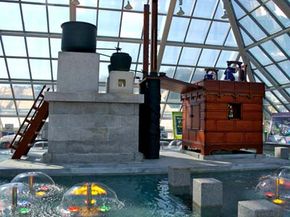Water-powered Clocks Through the Ages
Humans noticed the predictability of moving water long before recorded history. The oldest water clock we know of dates back to 1500 B.C., when it was interred in the tomb of Egyptian pharaoh Amenhotep I. The Greeks began using them around 325 B.C. and dubbed them clepsydras or "water thieves."
These early water clocks fell into two categories: outflow and inflow. In an outflow water clock, the inside of a container is marked with lines of measurement. Water leaks out of the container at a steady pace and observers tell time by measuring how much the water level has changed. For instance, if it takes one hour for the water level in the container to drop down one inch, then a three-inch drop in water level means that three hours have passed.
Advertisement
An inflow water clock follows the same basic principle, only the measurements are inside a second container, into which the first one drips. Either way, the measurement vessel is often bowel-shaped to ensure that it fills up gradually.
In some parts of the world, this technology survived unchanged up into the 20th century. In other areas, however, inquisitive minds elevated water clock technology to near Rube Goldberg proportions. You see, although a simple water clock operates with a certain degree of predictability, it's very difficult to maintain a constant, persistent flow.
Therefore, Greek and Roman engineers began regulating pressure in their water clocks between 100 B.C. and A.D. 500. While they were at it, they threw in bells, pointers and even mechanical displays involving moving doors and animated statues.
Meanwhile, Chinese engineers furthered their own water clock designs. By A.D. 1088, they were erecting elaborate water clock towers, some as tall as 30 feet (9 meters). Similar clocks were soon counting the hours in the Middle East.
Water clocks provided a reasonably reliable alternative to the sundial for ages. Yet the more engineers strove to perfect them, the more complicated water clocks became. The situation was hardly sustainable. For instance, when the century-old water clock in the Moroccan city of Fez stopped working in the mid 1400s, there was no one around to fix it. It remains inoperative to this day.
